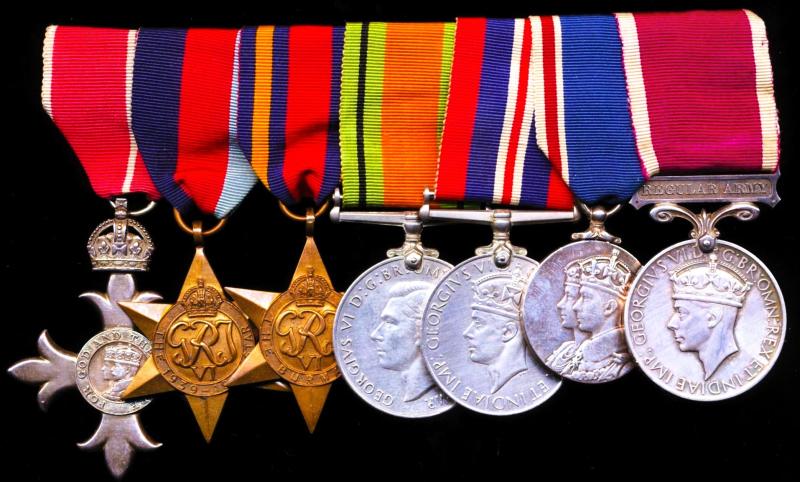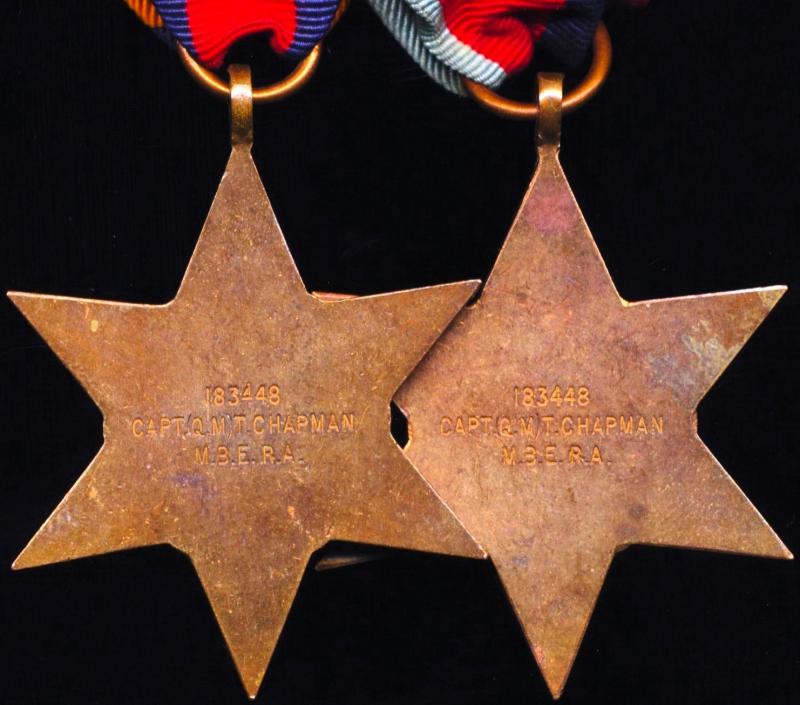A Second War ‘Burma theatre’ M.B.E. group of seven awarded to Captain T. Chapman, Royal Artillery, who served as Quartermaster of the 24th Anti Tank Regiment R.A. with the 7th Indian Division
- The Most Excellent Order of the British Empire, M.B.E. (Military) Member’s 2nd type, breast badge
- The 1939-45 Star. No star (183448 Capt (QM) T. Chapman M.B.E. R.A.)
- The Burma Star. No clasp (183448 Capt (QM) T. Chapman M.B.E. R.A.)
- Defence Medal (183448 Capt (QM) T. Chapman M.B.E. R.A.)
- War Medal (183448 Capt (QM) T. Chapman M.B.E. R.A.)
- Coronation Medal 1937
- Military LS&GC Medal. GVI 1st issue 'Regular Army' (1039297 W.O. Cl. II. T. Chapman. R.A.)
Note: All of the Second World War campaign medals are contemporary privately named
M.B.E. (Military) London Gazette 17 January 1946: ‘In recognition of gallant and distinguished services in Burma:-Captain (Quartermaster) Thomas Chapman, Royal Regiment of Artillery.’ The official recommendation is quoted below:
Quote,
This officer has served as Quartermaster of the Regiment since before it left England in 1941. By his loyalty, efficiency and industry he has contributed largely to the success of the Regiment in its participation in the campaigns of the Seventh Indian Division during the past two years, particularly in Burma between 15 February and 15 May 1945, when the Batteries of the Regiment were widely separated. His resourcefulness and untiring attention to the needs and requirements of ammunition, food and comforts for the personnel of the Batteries actively engaged against the enemy contributed very largely to the very high morale displayed on all occasions by all ranks of the Regiment. In and out of action during periods of reorganisation and refitting this officer has never spared himself in the work he has put in for the regiment, and his devotion to duty has been at all times worthy of the highest praise. The Regiment has often been called on to perform duties outside its normal roles, and its success in these duties has largely been due to the administrative work done by the Quartermaster and the very willing manner in which he has successfully shouldered the burden of the extra work entailed
Unquote
7th Indian Infantry Division February - May 1945: With regards to the specific period of actions referred to in the officer's recommendation, the 7th Indian Infantry Division was in the thick of the Burma fighting. During late February 1945, the division captured vital bridgeheads across the Irrawaddy River near Pakokku. During March, as part of the decisive Battle of Central Burma, the division was involved in several battles at Myingyan and Yenangyaung. During April, the division once again came under command of XXXIII Corps and advanced down the west bank of the Irrawaddy. After Rangoon, the capital, was captured in early May, the division was directly commanded by the new headquarters of Twelfth Army and resisted Japanese diversionary attacks across the Sittang River during the monsoon
Thomas Chapman, was a native of Ryde, Isle of Wight, Hampshire, England, where he was born in 1901. At the time he enlisted at the British Army, at Newport, on 3 October 1918, he described himself as a 'Farrier' by trade. His notified next of kin, his mother, was reported to be living at, 1 Milligan Road, Swanmore, Ryde, Isle of Wight. He had considerable experience of overseas service in British India, as apart from his service there in the period 1941-45, he had also first served in India as early as 1920
The medals mounted in the swing-style and as-worn in a laddered effect by the officer. The medals suspended from silk ribands on a white metal mounting bar, this latter retaining its original long hinged pin and clasp fittings
Sold with photocopied M.B.E. recommendation and extract page from the 1937 Coronation Medal Roll
Condition: GVF
Code: 23843
395.00 GBP







